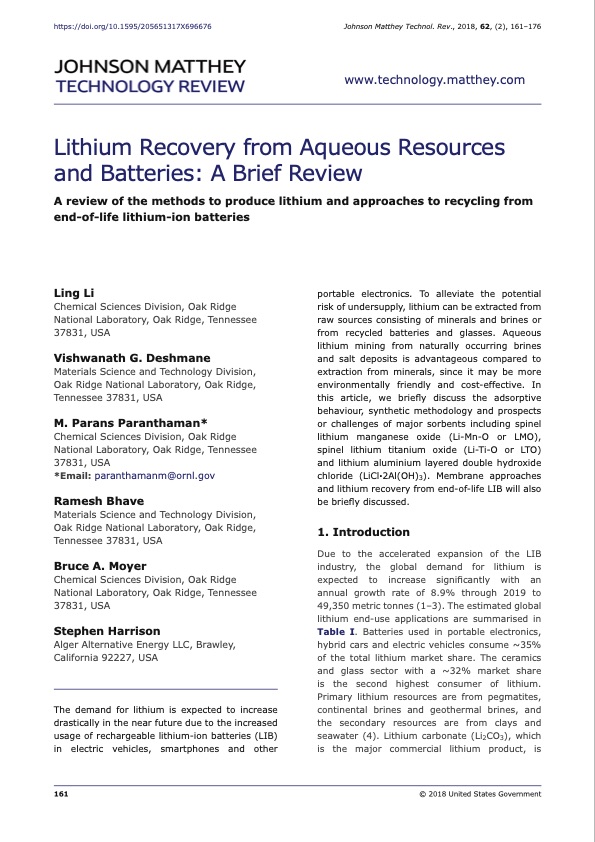
PDF Publication Title:
Text from PDF Page: 001
https://doi.org/10.1595/205651317X696676 Johnson Matthey Technol. Rev., 2018, 62, (2), 161–176 www.technology.matthey.com Lithium Recovery from Aqueous Resources and Batteries: A Brief Review A review of the methods to produce lithium and approaches to recycling from end-of-life lithium-ion batteries Ling Li Chemical Sciences Division, Oak Ridge National Laboratory, Oak Ridge, Tennessee 37831, USA Vishwanath G. Deshmane Materials Science and Technology Division, Oak Ridge National Laboratory, Oak Ridge, Tennessee 37831, USA M. Parans Paranthaman* Chemical Sciences Division, Oak Ridge National Laboratory, Oak Ridge, Tennessee 37831, USA *Email: paranthamanm@ornl.gov Ramesh Bhave Materials Science and Technology Division, Oak Ridge National Laboratory, Oak Ridge, Tennessee 37831, USA Bruce A. Moyer Chemical Sciences Division, Oak Ridge National Laboratory, Oak Ridge, Tennessee 37831, USA Stephen Harrison Alger Alternative Energy LLC, Brawley, California 92227, USA The demand for lithium is expected to increase drastically in the near future due to the increased usage of rechargeable lithium-ion batteries (LIB) in electric vehicles, smartphones and other portable electronics. To alleviate the potential risk of undersupply, lithium can be extracted from raw sources consisting of minerals and brines or from recycled batteries and glasses. Aqueous lithium mining from naturally occurring brines and salt deposits is advantageous compared to extraction from minerals, since it may be more environmentally friendly and cost-effective. In this article, we briefly discuss the adsorptive behaviour, synthetic methodology and prospects or challenges of major sorbents including spinel lithium manganese oxide (Li-Mn-O or LMO), spinel lithium titanium oxide (Li-Ti-O or LTO) and lithium aluminium layered double hydroxide chloride (LiCl·2Al(OH)3). Membrane approaches and lithium recovery from end-of-life LIB will also be briefly discussed. 1. Introduction Due to the accelerated expansion of the LIB industry, the global demand for lithium is expected to increase significantly with an annual growth rate of 8.9% through 2019 to 49,350 metric tonnes (1–3). The estimated global lithium end-use applications are summarised in Table I. Batteries used in portable electronics, hybrid cars and electric vehicles consume ~35% of the total lithium market share. The ceramics and glass sector with a ~32% market share is the second highest consumer of lithium. Primary lithium resources are from pegmatites, continental brines and geothermal brines, and the secondary resources are from clays and seawater (4). Lithium carbonate (Li2CO3), which is the major commercial lithium product, is 161 © 2018 United States GovernmentPDF Image | Lithium Recovery from Aqueous Resources

PDF Search Title:
Lithium Recovery from Aqueous ResourcesOriginal File Name Searched:
b8befda967a8ccf19190203d3b5aeae0673f.pdfDIY PDF Search: Google It | Yahoo | Bing
Product and Development Focus for Infinity Turbine
ORC Waste Heat Turbine and ORC System Build Plans: All turbine plans are $10,000 each. This allows you to build a system and then consider licensing for production after you have completed and tested a unit.Redox Flow Battery Technology: With the advent of the new USA tax credits for producing and selling batteries ($35/kW) we are focussing on a simple flow battery using shipping containers as the modular electrolyte storage units with tax credits up to $140,000 per system. Our main focus is on the salt battery. This battery can be used for both thermal and electrical storage applications. We call it the Cogeneration Battery or Cogen Battery. One project is converting salt (brine) based water conditioners to simultaneously produce power. In addition, there are many opportunities to extract Lithium from brine (salt lakes, groundwater, and producer water).Salt water or brine are huge sources for lithium. Most of the worlds lithium is acquired from a brine source. It's even in seawater in a low concentration. Brine is also a byproduct of huge powerplants, which can now use that as an electrolyte and a huge flow battery (which allows storage at the source).We welcome any business and equipment inquiries, as well as licensing our turbines for manufacturing.| CONTACT TEL: 608-238-6001 Email: greg@infinityturbine.com | RSS | AMP |